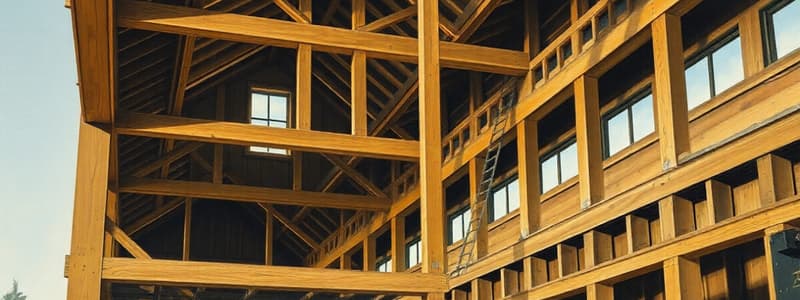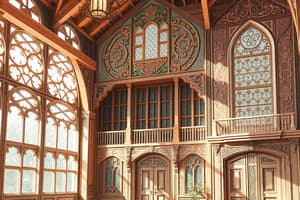Podcast
Questions and Answers
What is a primary characteristic of balloon framing?
What is a primary characteristic of balloon framing?
- It is constructed with closely spaced vertical wood members called studs. (correct)
- It uses thick, widely spaced vertical wood members.
- It incorporates a single continuous floor system.
- It consists of solid, heavy-load bearing materials.
Which of the following components is primarily responsible for providing bearing support between the concrete foundation and the wood frame?
Which of the following components is primarily responsible for providing bearing support between the concrete foundation and the wood frame?
- Cantilevered Joists
- Rim Joists
- Tail Joists
- Sill Plate (correct)
What characterizes the rigidity of a truss compared to a beam?
What characterizes the rigidity of a truss compared to a beam?
- A truss can accommodate larger spans than a beam.
- A truss is made of materials that are lighter than those of a beam.
- A truss is more rigid than a beam with the same amount of material. (correct)
- A truss is less rigid than a beam with the same amount of material.
What is the purpose of bridging, strapping, and blocking in floor framing?
What is the purpose of bridging, strapping, and blocking in floor framing?
Which of the following options is NOT a type of load in wood frame systems?
Which of the following options is NOT a type of load in wood frame systems?
Which factor does NOT typically influence floor performance?
Which factor does NOT typically influence floor performance?
What is the primary function of subfloors in wood frame systems?
What is the primary function of subfloors in wood frame systems?
What type of wall is referred to as non-loadbearing?
What type of wall is referred to as non-loadbearing?
What defines cantilevered floors in framing systems?
What defines cantilevered floors in framing systems?
What is a significant advantage of platform framing over balloon framing?
What is a significant advantage of platform framing over balloon framing?
I-joists are characterized as what type of floor joists?
I-joists are characterized as what type of floor joists?
What is the role of tail joists in a floor framing system?
What is the role of tail joists in a floor framing system?
Which type of load is typically constant and does not change over time?
Which type of load is typically constant and does not change over time?
What materials can be used for subfloors in floor framing systems?
What materials can be used for subfloors in floor framing systems?
What is a common building material used for subfloors?
What is a common building material used for subfloors?
Which type of truss is described as having members that form interconnected triangular forms?
Which type of truss is described as having members that form interconnected triangular forms?
What is the main function of ceiling joists in a roof system supported by a structural ridge beam?
What is the main function of ceiling joists in a roof system supported by a structural ridge beam?
Which table should be referenced for sizing ceiling joists?
Which table should be referenced for sizing ceiling joists?
What is a key advantage of using prefabricated wood trusses in construction?
What is a key advantage of using prefabricated wood trusses in construction?
How should wood trusses be handled during hoisting?
How should wood trusses be handled during hoisting?
What design is characterized by gable end trusses sitting on the end walls and carrying roof loads?
What design is characterized by gable end trusses sitting on the end walls and carrying roof loads?
What must be accounted for when sizing roof joists according to the content?
What must be accounted for when sizing roof joists according to the content?
Which of the following roof systems does not require ceiling joists to absorb lateral thrust?
Which of the following roof systems does not require ceiling joists to absorb lateral thrust?
Which of the following best describes a girder truss?
Which of the following best describes a girder truss?
What does the nominal span typically indicate in the design process?
What does the nominal span typically indicate in the design process?
What is the primary factor in determining the size of a beam?
What is the primary factor in determining the size of a beam?
What is the definition of an actual span?
What is the definition of an actual span?
What is the purpose of guards in building design?
What is the purpose of guards in building design?
Which of the following is NOT a consideration outlined in the Ontario Building Code for stair design?
Which of the following is NOT a consideration outlined in the Ontario Building Code for stair design?
In the Ontario Building Code, what does Section 9.8 primarily address?
In the Ontario Building Code, what does Section 9.8 primarily address?
What information does the height over stairs provide?
What information does the height over stairs provide?
Which of the following is used to determine the minimum depth of floor joists?
Which of the following is used to determine the minimum depth of floor joists?
Flashcards
Vaulted Ceiling
Vaulted Ceiling
A roof system where rafters are supported by a structural ridge beam, eliminating the need for ceiling joists to absorb lateral thrust.
Ceiling Joist Sizing
Ceiling Joist Sizing
Use Table A-3 to determine the appropriate size for ceiling joists based on span and load.
Roof Rafter Sizing
Roof Rafter Sizing
Use Tables A-6 and A-7 to determine the appropriate size for roof rafters based on span, load, and snow load.
Roof Truss Prefabrication
Roof Truss Prefabrication
Signup and view all the flashcards
Girder Truss
Girder Truss
Signup and view all the flashcards
Gable Roof Truss System
Gable Roof Truss System
Signup and view all the flashcards
Truss Uplift
Truss Uplift
Signup and view all the flashcards
OBC References for Roofing
OBC References for Roofing
Signup and view all the flashcards
Balloon Framing
Balloon Framing
Signup and view all the flashcards
Platform Framing
Platform Framing
Signup and view all the flashcards
Sill Plate
Sill Plate
Signup and view all the flashcards
Joist Depth
Joist Depth
Signup and view all the flashcards
Joist Spacing
Joist Spacing
Signup and view all the flashcards
Tail Joists
Tail Joists
Signup and view all the flashcards
Cantilevered Floors
Cantilevered Floors
Signup and view all the flashcards
Bridging, Strapping, Blocking
Bridging, Strapping, Blocking
Signup and view all the flashcards
I-Joists
I-Joists
Signup and view all the flashcards
Light Frame Wood Trusses
Light Frame Wood Trusses
Signup and view all the flashcards
Composite Trusses
Composite Trusses
Signup and view all the flashcards
Loadbearing Walls
Loadbearing Walls
Signup and view all the flashcards
Non-loadbearing Walls
Non-loadbearing Walls
Signup and view all the flashcards
Live Loads
Live Loads
Signup and view all the flashcards
Dead Loads
Dead Loads
Signup and view all the flashcards
Floor Sheathing
Floor Sheathing
Signup and view all the flashcards
Nominal Span
Nominal Span
Signup and view all the flashcards
Actual Span
Actual Span
Signup and view all the flashcards
Beam Size Factors
Beam Size Factors
Signup and view all the flashcards
OBC References
OBC References
Signup and view all the flashcards
Stair Width
Stair Width
Signup and view all the flashcards
Stair Treads and Risers
Stair Treads and Risers
Signup and view all the flashcards
Stair Configurations
Stair Configurations
Signup and view all the flashcards
Guards
Guards
Signup and view all the flashcards
Study Notes
Module 6
- Types & Terminology: Covers terminology related to roofs, including slopes, framing elements (ceiling joists, rafters, intermediate supports), and specific roof types (trusses, rakes, lookouts, flat roofs, sheathing, eaves, soffits, fascias, and chimneys).
- Roof Framing: Discusses ceiling joists, rafters, intermediate supports, sizing calculations, roof trusses, terminology and framing methods (conventional dimensional wood/stick framing, and pre-engineered framing)
- Roof Slopes: Explains roof pitch, expressed as rise/span, and conversion to degrees. Provides a table showing pitch calculations.
- Roof Framing-Hip & Valley Rafters: Describes the minimum depth and thickness requirements of hip and valley rafters relative to common rafters.
- Roof Rafters: Outlines situations where rafters require support from a ridge beam, specifying this as a vaulted or cathedral ceiling method.
- Roof Framing - End Bearing: States minimum length requirements for end bearing of joists and rafters.
- Intermediate Support: Explains roof support systems, including common rafters, collar ties. This may also address considerations for dwarf/knee walls and struts.
- Roof and Ceiling Framing - Openings: Discusses how to frame around openings larger than two joist or rafter spans. This describes adding supports on both sides of the openings.
- Roof Framing Sizing Ceiling Joists & Roof Rafters: Details steps for determining the sizes of ceiling joists and roof rafters. This emphasizes the importance of using tables for calculations, along with considering snow loads.
- Roof Framing - Sizing Roof Joists: Outlines the process for sizing roof joists based on span, and the need to consider snow loads.
Module 7
- Floor Framing Systems: Covers different systems like balloon framing and platform framing, and their anchor systems focusing on major components like headers, rim joists, headers, trimmers, tail joists, and cantilevered floors.
- Wood Frame Systems - Evolution: Discusses historical development and adaptation of light frame construction to various innovations (insulation, electricity, etc.). Highlights the efficiency and adaptability of wood framing systems
- Wood Frame Systems - Platform Framing vs Balloon Framing: Explains the differences between these two wood framing systems, noting that balloon framing is a heavy-load construction using closely spaced vertical members.
- Anchorage Systems: Explaining the function and importance of sill plates (mud sills), including providing bearing support, a level surface for wood framing and anchoring to the structure itself.
- Wood Sill Plate: States the need for sill gasket and 1/2" diameter anchor bolt installations.
- Fitting Sills to the Foundation: Explains the importance of filling gaps and providing proper support.
Module 8
- Spans: Describes two types of spans: nominal and actual span. Nominal span is the overall building dimension, while actual span is the distance between support points.
- Beams: Details how to calculate beam size for consideration of load and support distance. Explains different beam types such as steel beams, wood beams, and beam pockets.
- Additional Beam Types: This module outlines different types of beams commonly used in construction. Different types of lumber are considered (Parallam, PSL, Laminated Veneer... etc.).
Module 9
- Stairs: Discusses stair construction, component terminologies, various stair layouts, and fire-rated stair considerations.
Module 10
- Steps to Calculate Rise and Run: Provides the steps for calculating the total rise, number of risers, riser height, and total run of a staircase, considering OBC requirements.
- The Total Rise: Describes how to calculate the total height from one floor to another (using floor heights to determine overall height)
- The Number of Risers: Discusses the calculation of the number of risers considering the maximum and minimum rise constraints determined by OBC requirements, and then discusses how to handle non-whole number requirements.
- Height over stairs: Details the minimum acceptable height for stairs relative to different building types.
- The Total Run: This explains how to calculate the total run of a stairway and details different factors that may come into play when calculating a total run.
- Landings: Gives an overview of the criteria for placing landings in stairs, considering OBC requirements and avoiding any obstacles.
Studying That Suits You
Use AI to generate personalized quizzes and flashcards to suit your learning preferences.




